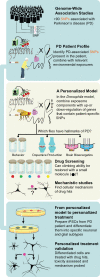Precision Medicine on the Fly: Using Drosophila to Decipher Gene-Environment Interactions in Parkinson's Disease
- PMID: 34076689
- PMCID: PMC8331128
- DOI: 10.1093/toxsci/kfab060
Precision Medicine on the Fly: Using Drosophila to Decipher Gene-Environment Interactions in Parkinson's Disease
Abstract
Big data approaches have profoundly influenced state-of-the-art in many fields of research, with toxicology being no exception. Here, we use Parkinson's disease as a window through which to explore the challenges of a dual explosion of metabolomic data addressing the myriad environmental exposures individuals experience and genetic analyses implicating many different loci as risk factors for disease. We argue that new experimental approaches are needed to convert the growing body of omics data into molecular mechanisms of disease that can be therapeutically targeted in specific patients. We outline one attractive strategy, which capitalizes on the rapid generation time and advanced molecular tools available in the fruit fly, Drosophila, to provide a platform for mechanistic dissection and drug discovery.
Keywords: Drosophila genetics; GWAS; Parkinson’s disease; exposome; gene-environment interactions; precision medicine.
© The Author(s) 2021. Published by Oxford University Press on behalf of the Society of Toxicology.All rights reserved. For permissions, please e-mail: journals.permissions@oup.com.
Figures
Similar articles
-
Gene-by-environment interactions in Alzheimer's disease and Parkinson's disease.Neurosci Biobehav Rev. 2019 Aug;103:73-80. doi: 10.1016/j.neubiorev.2019.06.018. Epub 2019 Jun 14. Neurosci Biobehav Rev. 2019. PMID: 31207254 Free PMC article. Review.
-
The Etiology of Parkinson's Disease: New Perspectives from Gene-Environment Interactions.J Parkinsons Dis. 2023;13(8):1281-1288. doi: 10.3233/JPD-230250. J Parkinsons Dis. 2023. PMID: 37980685 Free PMC article.
-
Gene-environment interactions within a precision environmental health framework.Cell Genom. 2024 Jul 10;4(7):100591. doi: 10.1016/j.xgen.2024.100591. Epub 2024 Jun 25. Cell Genom. 2024. PMID: 38925123 Free PMC article. Review.
-
A new Drosophila model to study the interaction between genetic and environmental factors in Parkinson's disease.Brain Res. 2014 Oct 2;1583:277-86. doi: 10.1016/j.brainres.2014.08.021. Epub 2014 Aug 15. Brain Res. 2014. PMID: 25130663
-
Modeling Parkinson's Disease Heterogeneity to Accelerate Precision Medicine.Trends Mol Med. 2019 Dec;25(12):1052-1055. doi: 10.1016/j.molmed.2019.09.004. Epub 2019 Oct 30. Trends Mol Med. 2019. PMID: 31676188
Cited by
-
Seminar: Functional Exposomics and Mechanisms of Toxicity-Insights from Model Systems and NAMs.Environ Health Perspect. 2024 Sep;132(9):94201. doi: 10.1289/EHP13120. Epub 2024 Sep 4. Environ Health Perspect. 2024. PMID: 39230330 Free PMC article. Review.
-
Gene-environment interactions in birth defect etiology: Challenges and opportunities.Curr Top Dev Biol. 2023;152:1-30. doi: 10.1016/bs.ctdb.2022.10.001. Epub 2022 Nov 14. Curr Top Dev Biol. 2023. PMID: 36707208 Free PMC article. Review.
-
Microglial ion channels: Key players in non-cell autonomous neurodegeneration.Neurobiol Dis. 2022 Nov;174:105861. doi: 10.1016/j.nbd.2022.105861. Epub 2022 Sep 14. Neurobiol Dis. 2022. PMID: 36115552 Free PMC article. Review.
-
A nerve-wracking buzz: lessons from Drosophila models of peripheral neuropathy and axon degeneration.Front Aging Neurosci. 2023 Aug 8;15:1166146. doi: 10.3389/fnagi.2023.1166146. eCollection 2023. Front Aging Neurosci. 2023. PMID: 37614471 Free PMC article. Review.
-
From bugs to bedside: functional annotation of human genetic variation for neurological disorders using invertebrate models.Hum Mol Genet. 2022 Oct 20;31(R1):R37-R46. doi: 10.1093/hmg/ddac203. Hum Mol Genet. 2022. PMID: 35994032 Free PMC article.
References
-
- Ascherio A., Schwarzschild M. A. (2016). The epidemiology of Parkinson’s disease: Risk factors and prevention. Lancet Neurol. 15, 1257–1272. - PubMed
-
- Betarbet R., Sherer T. B., MacKenzie G., Garcia-Osuna M., Panov A. V., Greenamyre J. T. (2000). Chronic systemic pesticide exposure reproduces features of Parkinson’s disease. Nat. Neurosci. 3, 1301–1306. - PubMed
Publication types
MeSH terms
Grants and funding
LinkOut - more resources
Full Text Sources
Medical
Molecular Biology Databases


